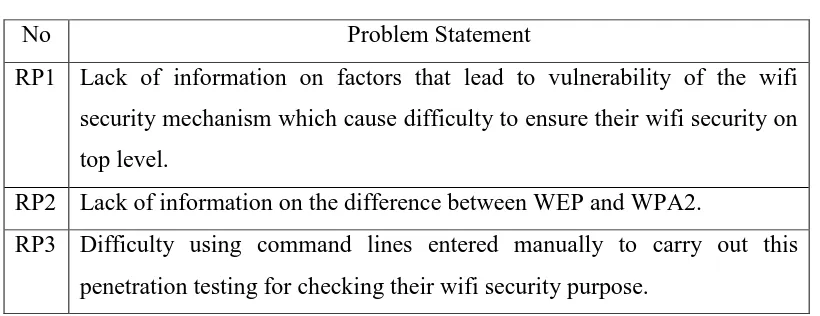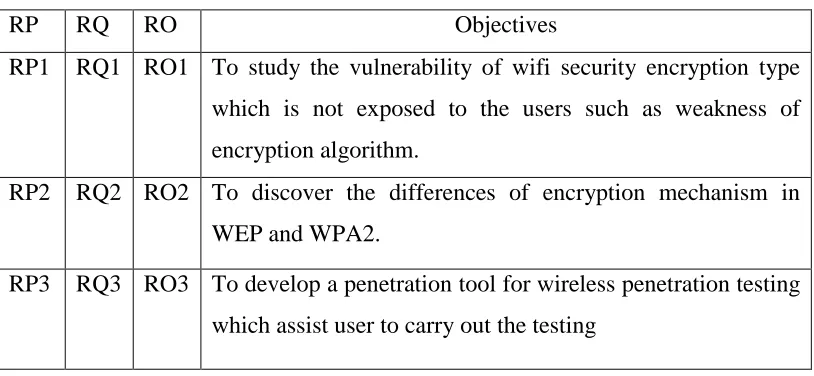DEVELOPING A WIRELESS PENETRATION TESTING TOOL IN LINUX PLATFORM
NOR ARLIZA BINTI ABDULLAH
This report is submitted in partial fulfilment of the requirements for the Bachelor of Computer Science (Computer Networking)
FACULTY OF INFORMATION TECHNOLOGY AND COMMUNICATION UNIVERSITI TEKNIKAL MALAYSIA MELAKA
i
DECLARATION
I hereby declare that this project report entitled
DEVELOPING A WIRELESS PENETRATION TESTING TOOL IN LINUX PLATFORM
is written by me and is my own effort and that no part has been plagiarized without citations.
STUDENT : _________________________ Date: _______________ (NOR ARLIZA BINTI ABDULLAH)
ii
DEDICATION
iii
ACKNOWLEDGEMENT
Firstly, I would like to express my gratitude to God for all the understanding during these three years in gathering and compiling this project. I also would like to thank my parents for keep praying and supporting and never let me give up in my study. I also would like to thank my Projek Sarjana Muda supervisor, Dr.Wahidah binti Md Shah for sacrificing her valuable time to assist me and thanks for her comments, motivations and idea and encouragement during this semester. I also would like to thank my classmates who encourage me to accomplish this project and willing to help if their help is needed.
iv
ABSTRACT
v
ABSTRAK
vi
TABLE OF CONTENTS
DECLARATION ... i
DEDICATION ... ii
ACKNOWLEDGEMENT ... iii
ABSTRACT ... iv
ABSTRAK ... v
LIST OF TABLES ... ix
LIST OF FIGURES ... x
LIST OF ABBREVIATIONS ... xii
CHAPTER 1 INTRODUCTION 1.1 Introduction ... 1
1.2 Problem Statements ... 3
1.3 Objectives ... 5
1.4 Scope ... 6
1.4.1 Software ... 7
1.4.2 Hardware ... 8
1.5 Expected Output ... 9
1.6 Report Organization ... 9
1.7 Conclusion ... 9
CHAPTER 2 LITERATURE REVIEW 2.1 Introduction ... 10
2.2 Related work ... 11
2.2.1 Vulnerabilities of Wifi ... 12
vii
2.2.1.2 Wi-Fi Protected Access (WPA) ... 17
2.2.1.3 Wi-Fi Protected Access version 2 (WPA2) ... 20
2.2.2 Differences of encryption mechanism ... 22
2.2.3 Penetration testing ... 25
2.3 Analysis of current problem ... 25
2.3.1 Security issue ... 26
i) WEP security issue ... 26
2.4 Proposed solution ... 29
2.5 Conclusion ... 31
CHAPTER 3 METHODOLOGY 3.1 Introduction ... 32
3.2 System model analysis ... 32
3.2.1 Incremental and Iterative model ... 33
3.3 Project Phase ... 35
3.4 Conclusion ... 36
CHAPTER 4 DESIGN AND IMPLEMENTATION 4.1 Introduction ... 37
4.2 High level design... 38
4.2.1 System Architecture ... 38
4.2.2 System flowchart... 40
4.2.3 Use Case Diagram ... 42
4.2.4 UML Statechart diagram ... 44
4.3 Project Requirements ... 45
4.3.1 Software Requirements ... 45
viii
ii) Backtrack operating system ... 46
4.3.2 Hardware Requirements ... 46
i) Laptop ... 46
ii) Wireless access point ... 46
iii) USB wifi adapter (AZTEC Wireless-N WL568USB Adapter) ... 47
4.4 Implementation ... 47
4.4.1 Software Development Environment Setup ... 47
4.4.2 Software Configuration Management ... 48
4.5 Conclusion ... 49
CHAPTER 5 TESTING AND ANALYSIS 5.1 Introduction ... 50
5.2 Testing procedure ... 50
5.3 Testing Result ... 52
5.3.1 WEP decryption ... 52
5.3.2 WPA decryption ... 57
5.3.3 WPA2 decryption ... 62
5.4 Result analysis ... 66
5.5 Conclusion ... 70
CHAPTER 6 CONCLUSION 6.1 Introduction ... 71
6.2 Future work ... 71
6.3 Limitation ... 72
6.4 Conclusion ... 72
REFERENCES ... 73
ix
LIST OF TABLES
Table 1.1: Problem Statement………4
Table 1.2 Research Problem………..4
Table 1.3: Objective………...6
Table 2.1: Comparison of WEP, WPA, and WPA2……….24
Table 2.2: Security issue in encryption mechanism……….28
Table 5.1: Description in console……….54
Table 5.2: Target network.……..……….66
Table 5.3: Time taken for decryption………...67
Table 5.4: Number of tested keys……….68
x
LIST OF FIGURES
Figure 2.1: Encryption Process……….13
Figure 2.2: WEP encryption process………14
Figure 2.3: Open authentication………...16
Figure 2.4: Shared key authentication………..16
Figure 2.5: WPA2 Authentication process………...…22
Figure 2.6: Commands line………..30
Figure 3.1: Incremental and Iterative model………34
Figure 4 1: System architecture……….………...………39
Figure 4.2: System flowchart…...….………..………..………...41
Figure 4.3: Use Case diagram………..43
Figure 4.4: UML Statechart diagram………...44
Figure 4.5: Implementation……….……….48
Figure 5.1: Script flow……….……….51
Figure 5.2: Monitor mode……….………52
Figure 5.3: Airodump-ng mon0 terminal……….53
Figure 5.4: User target‘s network……….55
Figure 5.5: Generate packet process……….56
Figure 5.6: WEP key decrypted………56
xi
Figure 5.8: Airodump-ng channel 1……….58
Figure 5.9: WPA handshake for nurul_wifi……….59
Figure 5.10: Airodump-ng command for WPA………...60
Figure 5.11: WPA decrypted key……….61
Figure 5.12: Target WPA2 network……….62
Figure 5.13: WPA network‘s information………63
Figure 5.14: Decrypted key for FluffyBoy network……….63
Figure 5.15: WPA handshake………...64
Figure 5.16: Passphrase not in dictionary……….65
Figure 5.17: Time taken for decryption graph………..67
xii
LIST OF ABBREVIATIONS
AES - Advance Encryption Standard
AP - Access point
BSSID - Broadcast service set identifier
CCMP - Cipher Block Chaining Message Authentication Code Protocol CIA - Confidentiality Integrity Authentication
CPU - Central Processing Unit
EAP - Extensible Authentication Protocol GUI - Graphical user interface
GTK - Group Temporal Key
ICV - Integrity check value ISP - Internet Service Provider IV - Initialization vector
IEEE - Institute of Electrical and Electronics Engineer MAC - Media access control
MPDU - Medium Access Control Protocol Data Unit MSDU - Medium Access Control Service Data Unit MIC - Message Integrity Code
OS - Operating system
xiii
PMK - Pair Master Key
PSK - Pre-Shared Key
PRNG - Pseudo Random Number Generator
RADIUS - Remote Authentication Dial-In User Service
RAM - Random Access Memory
SDLC - System Development Life Cycle SSID - Service set identifier
TKIP - Temporal key Integrity Protocol TLS - Transport Layer Security
WAP - Wireless access points WEP - Wired Equivalent Privacy WPA - Wireless Protected Access
WPA2 - Wireless Protected Access version 2 Wifi - Wireless Fidelity
1
CHAPTER 1
INTRODUCTION
1.1 Introduction
2
3
1.2 Problem Statements
1. Lack of information on factors that lead to vulnerability of the wifi security mechanism which cause difficulty to ensure their wifi security on top level
The vulnerability in the encryption mechanisms can be deployed to penetrate the network. Lack of information on factors that cause it leads to the penetration testing.
2. Lack of information on the difference between WEP and WPA2
Difficulty to differentiate between WEP and WPA2 encryption because of lack of information. The mechanisms used in these encryption types vary in a few aspects such as key length. The effectiveness of the mechanisms can only be known once the testing are done.
3. Difficulty using command lines entered manually to carry out this penetration testing for checking their wifi security purpose.
4
Table 1.1: Problem Statement
No Problem Statement
RP1 Lack of information on factors that lead to vulnerability of the wifi security mechanism which cause difficulty to ensure their wifi security on top level.
RP2 Lack of information on the difference between WEP and WPA2.
RP3 Difficulty using command lines entered manually to carry out this penetration testing for checking their wifi security purpose.
Table 1.2 : Research Problem
RP RQ Research questions
RP1 RQ1 What are the factors that cause vulnerability of wireless security mechanism?
[image:18.612.142.552.85.243.2]5
1.3 Objectives
This project embarks on the following objectives:
1. To study the vulnerability of wifi security encryption type which is not exposed to the users such as weakness of encryption algorithm.
2. To discover the differences of encryption mechanism in WEP and WPA2.
6
Table 1.3: Objective
RP RQ RO Objectives
RP1 RQ1 RO1 To study the vulnerability of wifi security encryption type which is not exposed to the users such as weakness of encryption algorithm.
RP2 RQ2 RO2 To discover the differences of encryption mechanism in WEP and WPA2.
RP3 RQ3 RO3 To develop a penetration tool for wireless penetration testing which assist user to carry out the testing
1.4 Scope
The scope for this project includes:
7
1.4.1 Software
i) Virtual machine software (VMWareWorksation)
Virtual machine enables users to set up multiple virtual machine (VMs). It allowed multiple virtual machines to be used concurrently along with the actual machine. Each virtual machine can execute its own operating system, such as Linux, Solaris and Microsoft Windows. VMware Workstation allows one physical machine to run multiple operating systems simultaneously. This software is developed and sold by VMWare.Inc.
ii) Backtrack operating system
8
1.4.2 Hardware
i) Laptop
The laptop used in this project has been installed 3 GB random access memory (RAM), with 32-bit architecture. This laptop running on windows 7 platform with the processor Intel® Core ™ 2 Duo processor T6600 central processing unit (CPU) running at cpu minimum 2.20 GHz .
ii) Wireless access point
Wireless access point (APs or WAPs) are specially configured nodes on wireless local area networks (WLANs). Access points act as a central transmitter and receiver of WLAN radio signals and support Wi-Fi wireless communication standards.
iii) USB wifi adapter (AZTEC Wireless-N WL568USB Adapter)
9
1.5 Expected Output
The expected results from this project are to help to carry out wifi penetration testing using bash script. Other than that, this project also expected to expose about the vulnerability of the wifi security mechanism. Other than that, this tool can also help to set up the wifi setting in security aspect.
1.6 Report Organization
This chapter consists of project background, problem statements, objectives, scope of this project and expected output from this project. Then, in chapter 2, related previous works is discussed. Analysis of current problem and proposed solution also is included in chapter 2. In chapter 3, methodology used for this project is explained in detail. Chapter 4 is discussed about design and implementation. All hardware and software requirement are stated in this chapter. In chapter 5, analysis and testing are done. All the steps on how to analyze are described in detail here. In chapter 6, the limitations, contributions, and future works are discussed there.
1.7 Conclusion
10
CHAPTER 2
LITERATURE REVIEW

